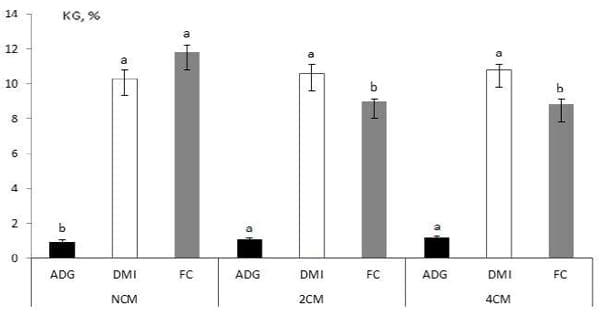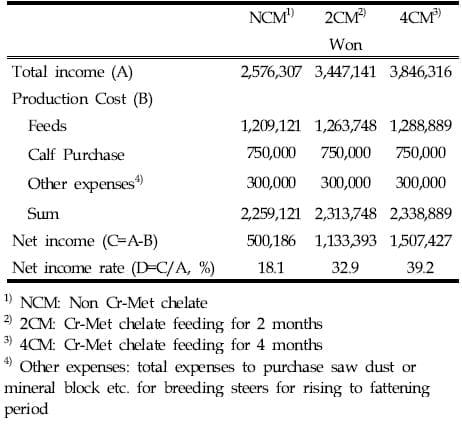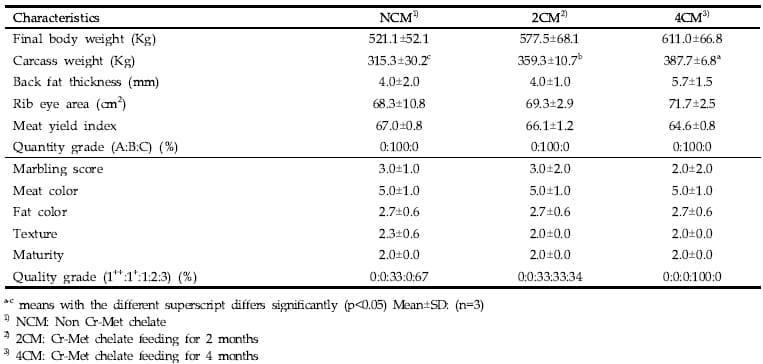INTRODUCTION
Chromium (Cr) has appeared as trace mineral that play a pivotal role in carbohydrate and lipid metabolism, along with protein synthesis, growth and longevity (Mertz, 1993). Furthermore, carcass quality and production is also influenced by stress level of animal during their growth and fattening stages. Since Cr has known to lessen the stress and strengthen the immune response, therefore, appropriate regimen of dietary Cr could be a metabolic pool to improve the carcass characteristics. Thus, a dietary supplementation of Cr has been suggested as a new approach to increase meat quality of animals (Ohh and Lee, 2005). Cr supplementation is well-known to decrease the level of blood total cholesterol, LDL cholesterol, and triglyceride but increase the level of HDL cholesterol (Anderson, 1995).
In order to increase biological availability, several Cr products have been developed. Among them, organic Cr has received much attention as it can be readily absorbed into the gut compared to inorganic form (Ohh and Lee, 2005). Among, many types of organic mineral complexes Cr-Met chelate is able to directly cross the intestinal cell membrane and be metabolized without any prior digestion, hence, bioavailability of Cr-Met chelate is proposed to be higher. Organic sources of Cr, such as Cr propionate or Cr-Met have demonstrated firm positive effects on glucose use, feed intake, and milk production in dairy cattle compared to other Cr mixtures (NRC, 1997; Hayirli et al., 2001). Hayirli et al. (2001), Kegley et al. (2000), and Mowat et al. (1993) carried out their research on the basis of different level and different source of Cr-Met (Kg of BW0.75), 30 ppb, chelated Cr 1 ppm, and Cr-Met 400 ppb/kg of DM, respectively. Variation among studies in response to Cr supplementation may relate to differences in Cr content and level or bioavailability from feed stuffs. Little is known regarding Cr concentrations and levels in practical feed stuffs and even less is known regarding bioavailability of Cr from common feed stuffs (Ohh and Lee, 2005). There are certain stages of feeding for different duration including growing, early fattening and late fattening periods. It seems that optimum feeding for different duration of Cr-Met is late fattening stage. But, there is no evidence about the effects of Cr-Met feeding for different durations in the late fattening stage of Holstein steers. Therefore, to investigate the optimum feeding of Cr-Met for different duration, the objective of the current study was to determine the effect of different feeding for different durations on growth and carcass characteristics in the late fattening stage of Holstein beef steers.
MATERIALS AND METHODS
Nine Holstein steers were randomly assigned to three dietary treatments; Non Cr-Met chelate feeding (NCM, 3 heads, av. BW of 433.3 kg), Cr-Met chelate feeding for 2 months (2CM, 3 heads, av. BW of 459.6 kg) and Cr-Met chelate feeding for 4 months (4CM, 3 heads, 490.0 kg). The feeding amount of Cr-Met chelate to an animal was limited to 400 ppb per day. The rate of forage to concentrate was 20:80 and forages were alfalfa cube and perennial ryegrass hay. The composition of the experimental feed is shown in Table 1. Feeding management of Holstein steers from growing to early fattening stage was based on grazing system followed by tie-stall feeding during experimental period in late fattening stage. Approximately analyses were done according to the AOAC (1990). NDF (neutral detergent fiber) and content of ADF (acid detergent fiber) were analyzed using the method of Goering and Van Soest (1991). Steers had ad libitum access to diets. Feed intake was calculated by looking at the refusal levels of 2 consecutive days after feeding. Body weight for measuring ADG every 60 days interval was measured using an electronic machine.
Table 1. Chemical composition of experimental feeds
Upon completing the feedlot experiment, the steers were slaughtered. Hot carcass weight and weight after 24 hours chilling period (2ºC) were recorded followed by measurement of back fat thickness (mm), rib-eye area (cm2), meat yield index, quantity grade, marbling score, meat color, fat color, texture, maturity, and quantity grade.
Statistical analysis for all the parameters (growth and carcass characteristics) was conducted using the GLM procedure of SAS (1999). Significant differences tested by the Duncan's multiple tests (Snedecor and Cochran, 1980) were carried out at the level of 5%.
RESULTS AND DISCUSSION
Dry matter intake and average daily gain
The average daily gain (ADG) was significantly higher in 4CM and 2CM than NCM (p<0.05). The results obtained are in agreement with Barajas et al. (2008) who reported that Cr-Met supplementation increased 7% ending weight and 14.5% average daily gain. Debski et al. (2004) reported that Cr not only enhances insulin binding to target cell receptors but also improves its post-receptor signaling, thus increases the protein synthesis and carbohydrate and lipid utilization. This may be the reason of increased ADG (Fig. 1) of steers fed with Cr-Met for different durations. Moreover, according to Bunting et al. (1994), the positive effect of Cr supplementation can be associated with its obvious influence on the systematic division of energy between adipose and lean tissue. Mowat et al. (1993) reported less stressful condition and 46% increase in daily gain in the calves fed chelated Cr supplemented diet. Dry matter intake showed no difference among all the treatments (p>0.05). Feed conversion (FC) ratio decreased in steers fed Cr-Met compare with NCM (p<0.05), however, no significant difference was found with supplementation time (p>0.05). Similar results were reported by Kegley et al. (2000), but Hong et al. (2002) stated that 400 ppb of Cr-Met inclusion in high forage diet improved feed efficiency in Korean steers. Therefore, 4CM is suitable to be used in ration to increase ADG in Holstein steers.
Fig. 1. Effects of Cr-Met chelate feeding for different durations on the ADG, DMI and FC of Holstein steers in the late fattening stage Error bar: Standard deviation, where n=3, a-b; means with different alphabet differ significantly (p<0.05) ADG: Average daily gain, DMI: Dry matter intake, FC: Feed conversion, NCM: Non Cr-Met chelate, 2CM: Cr-Met chelate feeding for 2 months, 4CM: Cr-Met chelate feeding for 4 months.
Table 2. Effects of Cr-Met chelate feeding for different durations on carcass characteristics of Holstein steers in the late fattening stage
Carcass characteristics and profitability
Cr supplementation has also been employed to manipulate the quality of meat due to its biological function on body fat and muscle metabolism (Hong et al., 2002), however, factors such as level of Cr supplementation, nutrients, chromium level in basal diet, breed and species may intervene with these functions. In present study we found no significant differences in carcass quantity (back fat thickness, rib-eye area, and meat yield index) except for carcass weight (p<0.05) and quality (marbling score, meat color, fat color, texture, and maturity) as shown in Table 2. However, carcass weight was higher in 4CM than other treatments whereas back fat thickness and rib-eye area tended to increase in 4CM group compared with other treatments (p<0.05).
Pollard et al. (2002) reported that organic Cr supplemented at 0.2 ppm tended to improve some economical carcass traits. However, supplementation of Cr to feedlot diets at levels of 0.4 ppm was detrimental to animal performance and may have resulted in reduced fat deposition and thus reduced consumer acceptability of cuts of meat from these carcasses (i.e. marbling). Dikeman (2007) and Domínguez-Vara et al. (2009) pointed that metabolic modifiers (i.e., anabolic steroids, somatotropin, and minerals fed in supra-nutritional levels) can increase growth rate, improve feed efficiency, increase carcass leanness, decrease carcass fatness, and improve efficiency and profitability of livestock production.
Table 3. Effects of Cr-Met chelate feeding periods on profitability of Holstein steers in the late fattening stage
Table 3 shows the profitability of this study. 4CM had higher total income than other treatments while no differences were observed in other expenses including calf purchase, extra expenses and sum. Net income and net income rate were the highest in 4CM among the other treatments. These results show that carcass characteristics and profitability could be improved in 4CM.
It is concluded that 4 months is an optimum period for feeding the Cr-Met chelate to improve the daily gain, carcass characteristics and profitability. However, this study still has uncertain evidences about the effects of Cr-Met chelate feeding for different durations due to the use of small number of animals. More careful and continuous studies are needed to confirm the definite results about the effects of Cr-Met chelate feeding for different durations in Holstein steers.
ACKNOWLEDGEMENTS
We are grateful to the funding by Korea Research Foundation (KRF-99-05-G00011)
REFERENCES
1. AOAC. 1990. Official Methods of Analysis, 15th ed. Association of Official Analytical Chemists. Washington DC, USA.
2. Anderson, R. A. 1995. Chromium, glucose tolerance, and lipid metabolism. J. Adv. Med. 8:37.
3. Barajas, R., Cervantes, B. J., Velazquez, E. A., Romo, J. A., Juarez, F. and Rojas, F. P. J. 2008. Chromium methionine supplementation on feedlot performance and carcass charactristics of bulls; results during cool season in the northwest of Mexico. Proceed. Anim. Sci. 59:374-377.
4. Bunting, L. D., Fernandez, J. M., Thompson, D. L. and Southern, L. L. 1994. Influence of chromium picolinate on glucose usage and metabolic criteria in growing Holstein calves. J. Anim. Sci. 72:1591-1597.
5. Debski, B., Zalewski, W., Gralak, M. A. and Kosla, T. 2004. Chromium-yeast supplementation of chicken broilers in an industrial farming system. J. Trace Elem. Med. Biol. 18:47-51.
6. Dikeman, M. E. 2007. Effects of metabolic modifiers on carcass traits and meat quality. Meat Sci. 77:121-135.
7. Domínguez-Varaa, I. A., González-Mu˜nozb, S. S., Pinos-Rodríguezc, J. M., Bórquez-Gasteluma, J. L., Bárcena-Gamab, R., Mendoza-Martíneze, G., Zapataf, L. E. and Landois-Palenciag, L. L. 2009. Effects of feeding selenium-yeast and chromium-yeast to finishing lambs on growth, carcass characteristics, and blood hormones and metabolites. Anim. Feed Sci. Technol. 152:42-49.
8. Goering, H. K. and Van Soest, P. J. 1991. Forage fiber analyses (apparatus, reagents, procedures, and some applications). Agric. Handbook. No.379. ARS, USDA, Washington DC.
9. Hayirli, A., Bremmer, D. R., Bertics, S. J., Socha, M. T., and Grummer, R. R. 2001. Effect of chromium supplementation on production and metabolic parameters in periparturient dairy cows. J. Dairy Sci. 84:1218-1230.
10. Hong, S. M., Sung, K. I., Ohh, S. J., Shin, J. S., Kim. C. H. and Kim, H. S. 2002. Effect of chromium methionine supplementation to castrated fattening steers on carcass quality and blood metabolites. Proceed. of Ann. Congress Korean Soci. Anim. Sci. Technol. p.196.
11. Kegley, E. B., Galloway, D. L. and Fakler, T. M. 2000. Effects of dietary chromium-L methionine on glucose metabolism of beef steers. J. Anim. Sci. 78:3177-3183.
12. Mertz, W. 1993. Chromium in human nutrition: a review. J. Nutr. 123:626-633.
13. Mowat, D. N., Chang, X. and Yang, W. Z. 1993. Chelated chromium for stressed calves. Can. J. Anim. Sci. 73:49-55.
14. NRC. 1997. The role of chromium in animal nutrition. National academy press, Washington DC.
15. Ohh, S. J. and Lee, J. Y. 2005. Dietary chromiummethionine chelate supplementation and animal performance. Asian-Aust. J. Anim. Sci. 18:898-907.
16. Pollard, G. V., Rechardson, C. R. and Karnesos, T. P. 2002. Effects of supplemental organic chromium on growth, feed efficiency and carcass characteristics of feedlot steers. J. Anim. Feed Sci. and Tech. 98:121-128
17. SAS Institute. 2001. SAS user's guide. Version 8 ed. SAS Inst. Inc., Cary, NC. USA.
18. Snedecor, G. W. and Cochran, W. G. 1980. Statistical methods. Iowa state university press one-way classifications. Analysis of variance.









.jpg&w=3840&q=75)